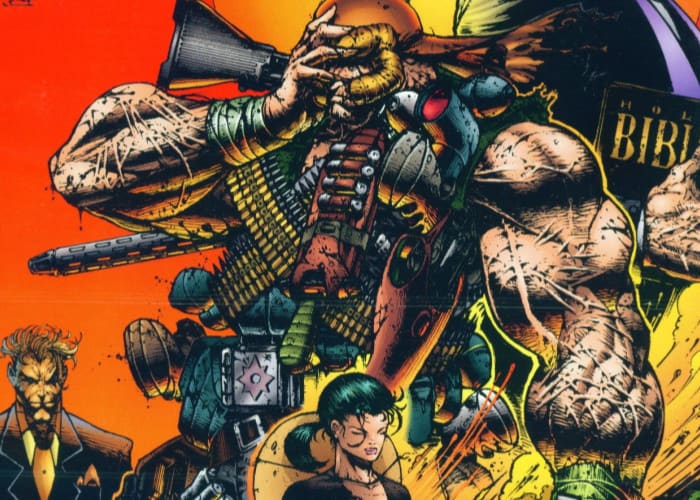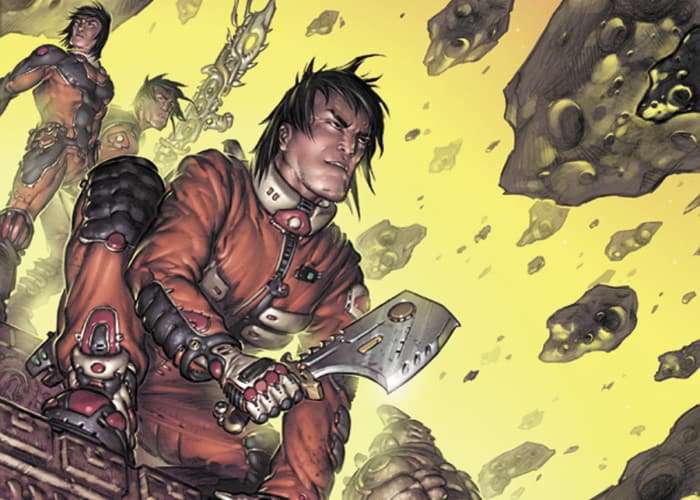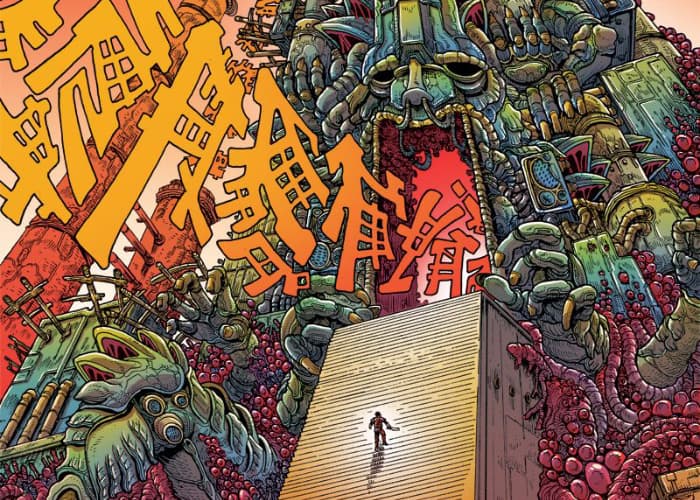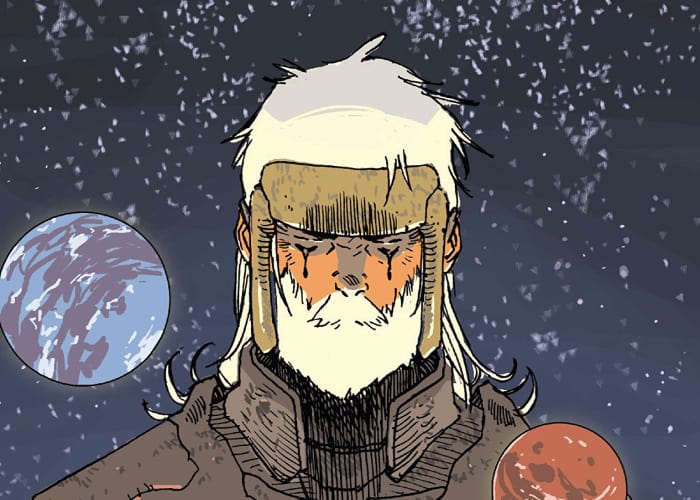Welcome to Pitch Meeting, a monthly column in which we suggest an IP ripe for adaptation, then assign the cast and crew of our dreams.
Reading comic books is a lot like tumbling into a massive, neverending game of telephone. What started as one thing is ultimately mutated into something utterly unrecognizable to the person who kicked off the whole shebang. The Captain America you read today is not the Captain America your father read, nor that your grandfather read. The character may have the name Steve Rogers (or he may not), but the emotions that motivate him and the environments he finds himself thrust upon, are vastly different.
The same goes for Superman, Spider-Man, Batman, Wonder Woman, and the rest. To survive decades of readership, protagonists must change, and even if the publishers attempt to maintain some sense of continuity, the very fact that hundreds and hundreds of different writers dig their pens into them radically alters their DNA. If you’re a stringent Wednesday Warrior who refuses to accept a Man of Steel minus his bright red trunks, then your time with the funny books is most likely filled with fist-waving tantrums or hate-filled Twitter threads.
Me? I say, thank the stars that comic books and their characters metamorphose routinely. The books you’ve already given the seal of approval still exist, and every once in a while, a new writer on a book will revolutionize a concept, injecting life into a void where there once was none. That’s exactly what happened to Prophet, and as a result of its transformation, there is tremendous potential for all of us to enjoy an epic science fiction space saga. Also, it’s just in time to ride the coattails of the similarily ambitious Dune movie from Denis Villeneuve.

John Prophet first appeared in Youngblood #2, written and illustrated by Rob Liefeld and published in July of 1992. He began life as an Extreme twist on the Steve Rogers story, with a little Winter Soldier tossed in for good measure (although Bucky’s dark days as a Soviet assassin would not be revealed till years later). The character is American might perverted and forgotten, only to emerge troubled and confused.
During World War II, a homeless John Prophet volunteered for an American supersoldier program concocted by a time-traveling scientist named Dr. Horatio Wells. Prophet was built to assist the maniacal designs of Phillip Omen, but at the last minute, Dr. Wells replaced his murderous programming with a righteous belief in a higher power. Prophet was placed in stasis for decades until he was discovered by Team Youngblood, but it was also revealed later that he had been temporarily released by the government to battle it out during the Vietnam conflict. The mass slaughter he perpetrated in the late 1960s left deep emotional scars.
I can already hear you yawning. What about all that space stuff you were promising? Yeah, yeah, yeah. I agree: we don’t need any of that ‘roided out superhero mumbo jumbo. We’ve got plenty of that. Don’t worry.
In 2012, everything changed with cartoonist Brandon Graham. Thousands and thousands and thousands of years in our future, when humanity has scattered to the farthest reaches and Earth is a husk of its former self, the character of John Prophet awakens from stasis once more. What begins as a savage attack across an alien landscape flips just a few issues in, when it’s revealed that there are multiple John Prophets roaming across the galaxy. The supersoldier is but one of many clones, and the series follows several of them as they make their way through a violent universe trapped in a forever war.

The visuals of this version of Prophet looks nothing like what came before. The drawings are nastier, grittier, rougher around the edges. Like Liefeld, Graham’s gang of artists (Simon Roy, Farel Dalrymple, and Giannis Milonogiannis) embraces extremity over realism, but instead of muscles upon muscles, and pouches upon pouches, the style exudes a softer touch skipping the heavier rendered designs of the 1990s. Prophet looks unlike any other comic book being published in America but feels right at home on European newsstands.
What began as a basic superhero punch-em-up, where big guns and big fists ruled the day, eventually evolved into a sprawling sci-fi fantasy where one John Prophet can’t trust another John Prophet, and the character you latched onto may not actually be the hero of the story. Graham’s goal when he took on the book was to deliver a Conan the Barbarian adventure fantasy that Robert E. Howard could not have possibly imagined. His Prophet is a dense, brutal, hypnotizing sci-fi canvas rich in character as it is in oddball, undefined alien lifeforms.
Last year, it was reported by Deadline that a possible Prophet film was in the works. An interest is there, and a hungry Rob Liefeld wants to make it happen. Although, reports circling the project tend to focus on the generation-one take on the concept. As already stated, we do not want this. Just go experience this weekend’s Bloodshot to see that particular, narrow-minded future.

Translating the feast into a cinematic work requires a filmmaker with European sensibilities, or better yet, just a plain ol’ European. Nicolas Winding Refn was the first name that jumped into mind when considering the idea. Anyone who has watched the documentary Jodorowsky’s Dune, which details the great science fiction adaptation that was never meant to be, knows how Refn longs to explore the fantastic and the design sensibilities of Heavy Metal magazine as well as the artist Moebius. All of that lives in Brandon Graham’s Prophet.
The human darkness that thrives in much of Refn’s films also exists in Prophet. There is a sense that nature is ravenous, eventually consuming everything it births. Graham never quite falls into nihilism, as his characters find their hope in the actions of others, but he also never treats them as precious. Those born a Prophet are not meant long for this world, and neither really are any of us.
To capture the style and design of the series, I would point producers to the pulsating, pulpy flash of Blood Machines. All you need to know about that trippy science fiction flick from last year is right there in the IMDb plot description: “An artificial intelligence escapes her spaceship to turn into a female ghost and challenges two blade runners to a galactic chase.” Much of the film is mad lunacy, but it’s draped in a neon glow that’s more slime than light. The color tones of Prophet are much more muted, but the gusto in which cinematographer Philip Lozano illuminates the frame and commands his palate is necessary.

For Prophet and his many clones, you need an actor who can sell any age while standing next to his mirror. Motion capture will take care of the technical details, while the art exists in the performance. Resist the urge to reteam Refn with Ryan Gosling. The pair could easily work here, but Gosling’s Blade Runner 2049 replicant might align a little too closely with one or two of the John Prophets. One iteration of the character might require stillness, but another will play manic and another crazed and another jubilant. Such a description recalls James McAvoy in Split, but again, too dead-on. Let’s shake it up a little.
Caleb Landry Jones is our John Prophet(s). Most of us took notice when he oozed hatred from his pores as the wretched Jeremy Armitage in Get Out. There’s a John Prophet to match that punk. In Three Billboards Outside Ebbing Missouri, Jones was the meek salesman who could puff his chest in defiance but cave when violence rained down upon him. There’s a John Prophet to match him there. The closest Jones has come to screaming comic book heroism was for Matthew Vaughn in X-Men: First Class. Banshee may not have been the mutant standout, but there’s a John Prophet who can take Jones to action star Valhalla without betraying his critical cred.
In the wake of Deadpool, Rob Liefeld has seemingly scored a little IP cred with Studio 8 sniffing around Prophet and Netflix laying claim on his Extreme Studios. The character rests in his hands, but hopefully, he has enough good sense to get wild with Brandon Graham’s take on his creation. A filmmaker could lean one way and deliver a perfectly ordinary bit of spandex nonsense. A filmmaker could lean the other way, and deliver a psychedelic trip beyond the infinite baked in cryptic mythology.
Graham throws you into the deep end, and it may take a trade paperback or two (there are five in total) to parse through the intricacies of the plot. Once you do, however, the reward transforms you into a proud member of the Prophet cult. You’ll be slapping this comic into people’s hands for years to come.

0 comments:
Post a Comment